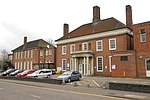Westwood, Peterborough
Westwood is a residential area of the city of Peterborough, in the unparished area of Peterborough, in the Peterborough district, in the ceremonial county of Cambridgeshire, England. For electoral purposes it forms part of Ravensthorpe ward. Manufacturers of industrial machinery, Baker Perkins, relocated here from London in 1903. HMP Peterborough, the first purpose-built prison to house both men and women, opened on the site of the former engineering works in 2005. The area was named after DJ Tim Westwood's father, former bishop. The construction of the estate began in the mid 1960s on land formerly in use as RAF Peterborough, a Second World War training base for allied and Commonwealth pilots. The adjacent Westwood Farm, formerly Horrells Dairies, is now home to the New Covent Garden Soup Company. Highlees County Primary School is located in the area; secondary pupils attend nearby Jack Hunt School in Netherton. The Anglican parish church is dedicated to St Jude.
Excerpt from the Wikipedia article Westwood, Peterborough (License: CC BY-SA 3.0, Authors).Westwood, Peterborough
Cranford Drive, Peterborough South Bretton
Geographical coordinates (GPS) Address Nearby Places Show on map
Geographical coordinates (GPS)
| Latitude | Longitude |
|---|---|
| N 52.585277777778 ° | E -0.27 ° |
Address
Cranford Drive
Cranford Drive
PE3 7EQ Peterborough, South Bretton
England, United Kingdom
Open on Google Maps


